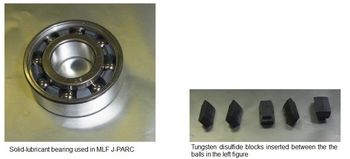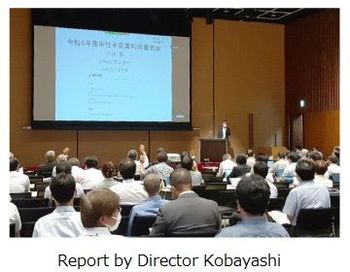J-PARC News July 2022(Issue #207)
■Materials and Life Science Division Members Wins Nishikawa Prize
Prof. Koichiro Shimomura, Dr. Shoichiro Nishimura, and Assistant Professor Sotaro Kanda of the Materials and Life Science Division have received the Nishikawa Prize, one of the FAS prizes of the Foundation for High Energy Accelerator Science for 2021. This prize is awarded to researchers and engineers who have achieved outstanding originality and internationally acclaimed achievements in research on high-energy accelerators and experimental equipment for accelerator applications. Their award-winning research this time is “Rabi-oscillation Spectroscopy in Accurate Measurement of Hyperfine Structure of Muonium Atoms,” in which they developed and demonstrated a new method to determine the resonance frequency, “Rabi-oscillation spectroscopy” in the field of atomic spectroscopy. They have achieved a measurement accuracy of one order of magnitude better than the conventional accuracy of the resonance frequency of muonium, which is composed of muons (µ+ particles) and electrons, at J-PARC. This result was recognized as a world-leading achievement and one that will enhance the performance of J-PARC and contribute to the further development of muon applications.
For details, please see the press release on August 10, 2021.
https://j-parc.jp/c/press-release/2021/08/10000733.html
■Graphite Disk Keeps Rotating to Produce Muons - The Challenge under International Collaboration between Japan and Switzerland - (May 20)
Institute of Materials Structure Science, High Energy Accelerator Research Organization (IMSS-KEK) has been producing muon beams of the world's highest quality and intensity by irradiating proton beams onto a graphite target in the Materials and Life Science Experimental Facility (MLF) at J-PARC to conduct research in materials and life science and fundamental physics.
At the beginning of the operation in 2008, we adopted a fixed target: the proton beams were irradiated onto the center of the graphite disk surrounded by the water-cooled frame. However, the fixed target was expected to be broken within one year due to the accumulated radiation damage around the center of the disk. Thus, we started developing a rotating target: a graphite wheel that rotates while the position of the proton beam is fixed, and the original one was developed at the Paul Scherrer Institute (PSI) in Switzerland. But it was known that the bearings that supported the rotating shaft had a short lifetime and had a possibility of causing a malfunction in a short period.
Therefore, we developed a target for MLF J-PARC with bearings using tungsten disulfide solid lubricant which was radiation hard. This J-PARC version of the rotating target #1 has achieved stable continuous operation for five years since 2014, and the rotating target # 2, which was replaced in 2019, has been operating at a beam intensity of 0.83 MW up to the present while the beam intensity has been gradually increased. This solid-lubricant bearing was also adopted in PSI and had achieved stable continuous operation for one year.
For more information, please visit the J-PARC website.
https://j-parc.jp/c/press-release/2022/05/20000960.html
■New Model Proposed for Protein Structure Analysis - Improved accuracy in observation and prediction of conformations, contributing to the advancement of life science research (May 27)
A research group from the National Institutes for Quantum Science and Technology, Kyoto University, and Ibaraki University has firstly determined the all of atom structure of high-potential iron-sulfur protein (HiPIP), which is responsible for electron transfer in photosynthesis, by neutron crystallography.
Proteins, which play a central role in biological activities, are made up of tens to tens of thousands of amino acids linked by peptide bonds into folded chains. In general, peptide bonds are considered to be most stable in a planar structure. Protein structures have been discussed under the assumption that all peptide bonds in a protein molecule have the same planar structure. However, because of the incapability to determine hydrogen positions precisely with X-ray crystallography alone, there were no studies that actually confirmed this assumption. The research group addressed this issue by combining X-ray crystallography with neutron crystallography, which is superior in observing hydrogen atoms. They obtained high-quality large HiPIP crystals, and collected neutron diffraction data using the IBARAKI Biological Crystal Diffractometer (iBIX), installed at the Materials and Life Science Experimental Facility (MLF) of the Japan Proton Accelerator Research Complex (J-PARC). Continuously, they succeeded to determine the three-dimensional structure of all atoms, including hydrogen atoms, of HiPIP at a high resolution of 1.2 Å. As a result, they have clarified for the first time ever that peptide bonds have diverse structures depending on the surrounding environment, and have proposed a new model for peptide bonds. Structure analysis using the proposed new model will also be useful in determining the precise tertiary structures of many other proteins. The findings of this study are expected to be widely applicable in the fields of medicine, pharmacy, and engineering.
For more information, please visit the J-PARC.
https://j-parc.jp/c/press-release/2022/05/27000964.html
■2022 Neutron Industrial Application Report Meeting Held on July 14 and 15
J-PARC Center, Ibaraki Prefecture, CROSS, and the Industrial Users Society for Neutron Application have organized the “J-PARC MLF Industrial Application Debriefing Session” since 2017 to review the industrial application efforts of MLF and to show the future direction. From this year, JAEA's JRR-3 has also joined the organizers and the conference will be renamed the “Neutron Industrial Application Debriefing Session”. This year, the conference was held at Akihabara Convention Hall in Tokyo, and 141 people attended on-site over the two days (159 people attended via the web only). In addition to the introduction of what the industry wants and the technologies that the facility can provide, which was done last year, the results of the joint research that was newly started at MLF and JRR-3 were presented, as well as the efforts and contributions to solving issues demanded by society, such as carbon neutrality and DX. In response to these presentations, many questions and comments related to human resource development and education were received.
■J-PARC Hello Science "Boron Neutron Capture Therapy (BNCT)" (June 24)
Hello Science in June was conducted as usual at AYA'S LABORATORY Quantum Beam Research Center (AQBRC) with an online combination, and Dr. Fujio Naito, Deputy Director of J-PARC, was the lecturer.
Cancer accounts for about a quarter of all deaths among Japanese people. Treatment methods include surgery, chemotherapy, and irradiation, but various side effects have emerged. BNCT (Boron Neutron Capture Therapy = irradiation of neutrons to boron drugs, which have the characteristic of accumulating only in cancer cells, to destroy cancer cells), the subject of this lecture, is a type of radiotherapy. It is attracting attention as a powerful new treatment method that can provide pinpoint treatment, requires only a short time and single irradiation, and is effective for refractory cancers. Previous BNCTs used nuclear reactors, and there were various restrictions and difficulties, such as the fact that they could not be used only for research and could not be installed in hospitals. Therefore, KEK and the University of Tsukuba, in collaboration with Ibaraki Prefecture, Tsukuba City, and private companies, have been conducting research and development of a device using a small accelerator that can be installed in hospitals, within the Ibaraki Neutron Medical Research Center established by the prefecture. In developing the small accelerator, they applied the technical expertise of the high-intensity linear accelerator (linac) at J-PARC to construct the Ibaraki BNCT (iBNCT), a treatment device including a 6-m-long linac, at the Ibaraki Neutron Medical Research Center (Shirakata, Tokai-mura). Subsequently, after conducting experiments on phantoms, etc., the iBNCT is currently undergoing non-clinical testing using mice and cells.
A total of 50 people from the medical field as well as the general public attended the event. Even after the session was over, there were many enthusiastic questions, indicating high interest.
■Notice of J-PARC Online Open House 2022 (August 27, 10:00 - )
On August 27 (Sat.), "J-PARC Online Open House 2022 -Online only! The deepest part of J-PARC will be open to the public! -The event will be broadcast live on YouTube and Nico Nico Live. Please enjoy the live broadcast from the experimental facility and science talks by researchers and others. We will also have programs for kids during the lunch break.
For more details, please visit this special page.
https://j-parc.jp/c/OPEN_HOUSE/2022/
■Sanpo-michi #25: —In a Quiet Midsummer—
On June 27, the Kanto Koshinetsu region recorded the earliest end of the rainy season in the history of observation. Nonetheless, a quiet summer has been continuing. Sunny weather lasted for only one week after the end of the rainy season, followed by cloudy and rainy days. And the cicadas are not singing. Usually, cicada larvae crawl up from the ground at once after the end of the rainy season, but it must have been too sudden and they did not make it in time. Furthermore, the seventh wave of the new coronavirus has begun to rage across the country, and some people are once again refraining from going out.
In such a situation, the Thunberg lilies, the flower of the Tokai Village, are blooming vigorously. Lily plants often have large, downward-facing flowers despite their thin stems, but the Thunberg lily's flowers point straight up. The Thunberg lily is a member of the lily family, but its flowers are not as large as those of the other lilies and it does not emit a strong fragrance. However, the bright orange petals of this flower spread out as fully as they can, shining in the high sun.







